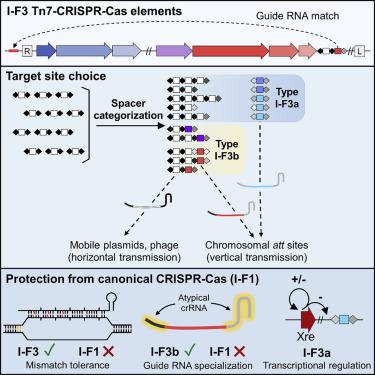Cell ( IF 45.5 ) Pub Date : 2020-12-02 , DOI: 10.1016/j.cell.2020.11.005 Michael T Petassi 1 , Shan-Chi Hsieh 1 , Joseph E Peters 1

|
CRISPR-Cas defense systems have been coopted multiple times in nature for guide RNA-directed transposition by Tn7-like elements. Prototypic Tn7 uses dedicated proteins for two targeting pathways: one targeting a neutral and conserved attachment site in the chromosome and a second directing transposition into mobile plasmids facilitating cell-to-cell transfer. We show that Tn7-CRISPR-Cas elements evolved a system of guide RNA categorization to accomplish the same two-pathway lifestyle. Multiple mechanisms allow functionally distinct guide RNAs for transposition: a conventional system capable of acquiring guide RNAs to new plasmid and phage targets and a second providing long-term memory for access to chromosomal sites upon entry into a new host. Guide RNAs are privatized to be recognized only by the transposon-adapted system via sequence specialization, mismatch tolerance, and selective regulation to avoid toxic self-targeting by endogenous CRISPR-Cas defense systems. This information reveals promising avenues to engineer guide RNAs for enhanced CRISPR-Cas functionality for genome modification.
中文翻译:

引导 RNA 分类可实现 Tn7-CRISPR-Cas 转座子中的靶位点选择
CRISPR-Cas防御系统在自然界中已多次被用来指导Tn7样元件的RNA指导转座。原型 Tn7 使用专用蛋白实现两种靶向途径:一种靶向染色体中的中性且保守的附着位点,第二种定向转座到移动质粒中,促进细胞间转移。我们证明,Tn7-CRISPR-Cas 元件进化出了指导 RNA 分类系统,以实现相同的双途径生活方式。多种机制允许功能不同的引导RNA进行转座:一个传统系统能够获取新质粒和噬菌体靶标的引导RNA,第二个系统提供长期记忆,以便在进入新宿主时访问染色体位点。向导RNA被私有化,通过序列特化、错配容忍和选择性调节,只能被转座子适应系统识别,以避免内源性CRISPR-Cas防御系统产生有毒的自靶向。这一信息揭示了设计引导RNA以增强基因组修饰的CRISPR-Cas功能的有希望的途径。











































 京公网安备 11010802027423号
京公网安备 11010802027423号